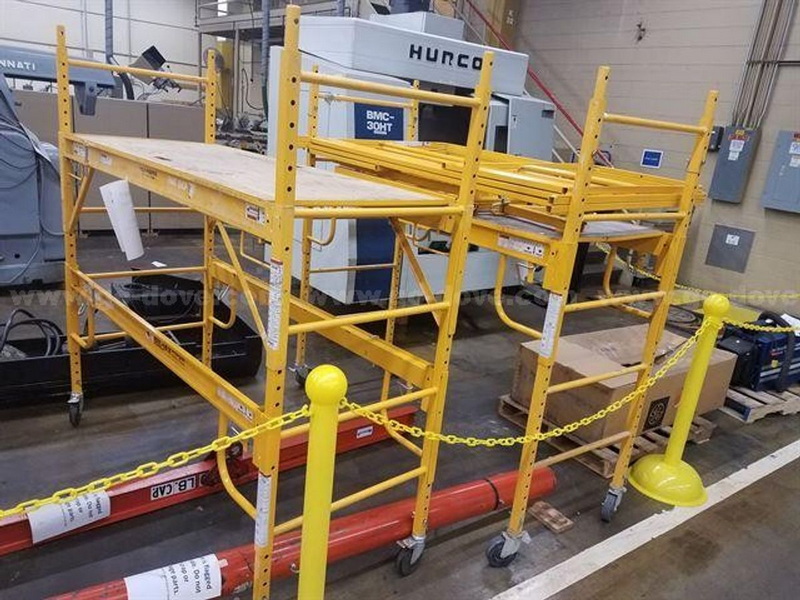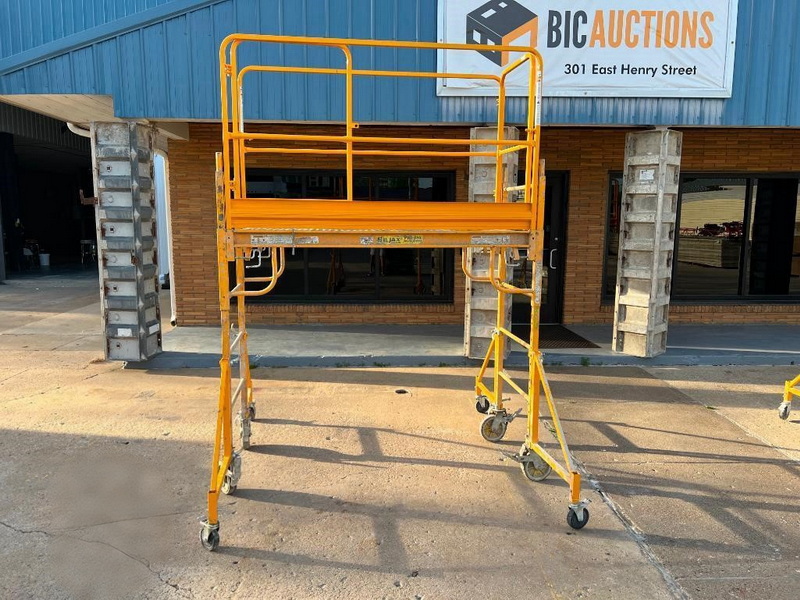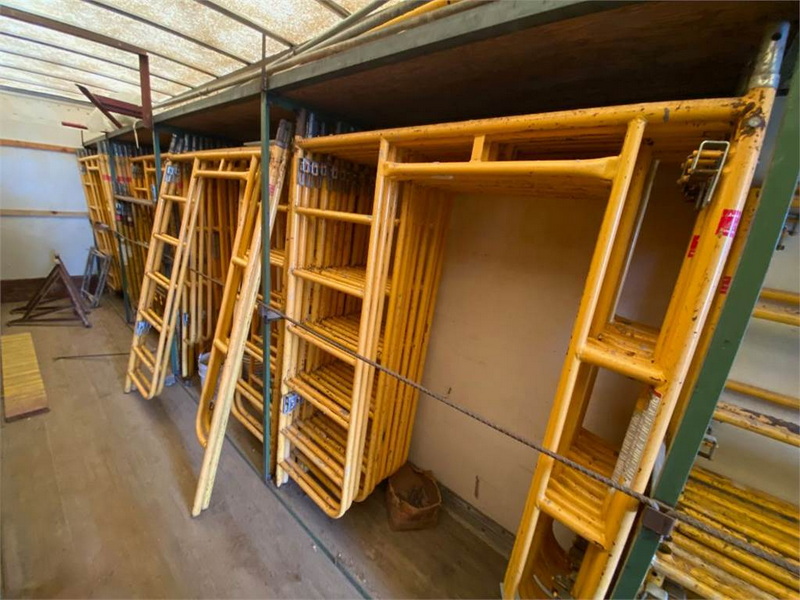Content Menu
● What is the JAX Scaffolding System?
● Key Features of the JAX Scaffolding System for Industrial Use
>> 1. Heavy-Duty Load Capacity
>> 2. Modular Flexibility
>> 3. Mobility and Stability
>> 4. Corrosion Resistance
● Industrial Applications of the JAX Scaffolding System
>> 1. Oil and Gas Facilities
>> 2. Power Plants
>> 3. Shipbuilding and Repair
>> 4. Manufacturing Plants
>> 5. Chemical and Pharmaceutical Facilities
● Comparison: JAX Scaffolding vs. Traditional Industrial Scaffolding
● Safety and Compliance in Industrial Settings
>> Integrated Safety Features
>> Inspection Protocols
>> Training Requirements
● Case Study: JAX Scaffolding in a Petrochemical Plant
● Innovations and Future Trends
>> Smart Scaffolding
>> Hybrid Materials
>> Robotic Assembly
● Limitations and Considerations
● Conclusion
● FAQ
>> 1. What industrial environments is the JAX Scaffolding System best suited for?
>> 2. Can the JAX system withstand extreme temperatures?
>> 3. How does the JAX system improve safety in hazardous zones?
>> 4. What is the maximum height for industrial JAX Scaffolding?
>> 5. How does the cost compare to traditional industrial scaffolding?
The JAX Scaffolding System (commonly branded as Bil-Jax® scaffolding) has earned a reputation as a versatile, durable, and safety-focused solution for construction and maintenance projects. But its capabilities extend far beyond residential or commercial use-industrial applications demand robust, adaptable, and high-capacity scaffolding systems.

What is the JAX Scaffolding System?
The JAX Scaffolding System is a modular, engineered scaffolding solution designed for strength, flexibility, and rapid assembly. Key components include:
- Ring-Lock Verticals: Steel or aluminum posts with rosette joints for secure connections.
- Trusses and Braces: Stabilize verticals and span large areas.
- Walkboards: Slip-resistant platforms (steel or aluminum) for workers and materials.
- Accessories: Guardrails, leveling jacks, casters, and outriggers for customization.
Key Features of the JAX Scaffolding System for Industrial Use
1. Heavy-Duty Load Capacity
- Steel Construction: Supports up to 75 lbs/sq ft, ideal for industrial machinery, piping, and equipment.
- Expanded Metal Walkboards: Provide traction and durability in high-impact environments like refineries or shipyards.
- Dynamic Load Handling: Engineered to withstand vibrations from heavy machinery, ensuring stability in active industrial zones.
2. Modular Flexibility
- Ring-Lock Design: Rosette joints allow 360-degree connections, enabling complex configurations around equipment or structures.
- Adjustable Heights: Vertical posts can be extended or shortened incrementally (0.5m increments) to match precise site requirements.
- Interchangeable Components: Mix steel and aluminum parts for hybrid solutions balancing strength and portability.
3. Mobility and Stability
- Casters with Brakes: Heavy-duty polyurethane wheels (up to 6-inch diameter) enable smooth repositioning in factories or warehouses.
- Outriggers and Base Plates: Stabilize the system on uneven or slippery surfaces, with adjustable screw jacks compensating for slopes up to 5°.
- Anchoring Systems: Ground spikes and chemical anchors secure scaffolds in outdoor or high-wind environments.
4. Corrosion Resistance
- Galvanized Finish: Hot-dip galvanization protects against rust in offshore oil rigs or chemical plants.
- Anodized Aluminum Options: Ideal for marine environments, resisting saltwater corrosion for 10+ years with minimal maintenance.
Industrial Applications of the JAX Scaffolding System
1. Oil and Gas Facilities
- Platforms for Maintenance: Access drilling rigs, pipelines, and storage tanks at heights up to 150 feet.
- Scaffold Configuration: Ring-lock trusses span 6-meter gaps, while side brackets support welding and pipefitting.
- Case Example: In the North Sea, JAX scaffolds with non-sparking aluminum components reduced explosion risks during gas pipeline repairs.
2. Power Plants
- Turbine Access: Custom scaffolds with heat-resistant walkboards (1,000°F rating) provide safe access to coal-fired boiler interiors.
- Radiation Shielding: Lead-lined panels integrate with JAX frames in nuclear facilities for maintenance in controlled areas.
- Case Example: A Texas power plant reduced turbine inspection downtime by 60% using mobile JAX towers with integrated tool racks.
3. Shipbuilding and Repair
- Dry Dock Scaffolding: Modular systems adapt to curved hulls using adjustable brackets and flexible walkboards.
- Corrosion-Resistant Materials: Aluminum components with marine-grade coatings prevent saltwater degradation in shipyards.
- Case Example: A South Korean shipyard used JAX scaffolds to repair a 300-meter cargo vessel, completing the project 3 weeks ahead of schedule.
4. Manufacturing Plants
- Assembly Line Maintenance: Rolling towers with 360° casters allow repositioning without disassembly during active production.
- Overhead Work: Suspended scaffolds access 20-meter-high conveyor systems in automotive plants.
- Case Example: A German automotive factory implemented JAX scaffolds with IoT load sensors to prevent overloading during robotic arm maintenance.
5. Chemical and Pharmaceutical Facilities
- Non-Sparking Components: Aluminum options meet OSHA 1910.178(c) standards for explosive atmospheres.
- Containment Solutions: Sealed platforms with HEPA filters prevent cross-contamination in cleanroom environments.
- Case Example: A Pfizer facility used JAX scaffolds with antimicrobial coatings during vaccine production line upgrades.

Comparison: JAX Scaffolding vs. Traditional Industrial Scaffolding
| Feature | JAX Scaffolding System | Traditional Tube-and-Clamp Scaffolding |
| Assembly Time | 30–50% faster due to modular design | Time-consuming bolt tightening |
| Load Capacity | Up to 75 lbs/sq ft | 25–50 lbs/sq ft |
| Corrosion Resistance | Galvanized steel/aluminum | Requires frequent coating maintenance |
| Mobility | Integrated casters/outriggers | Rarely mobile; fixed installations |
| Customization | Rosette joints enable 360° configurations | Limited by pipe lengths and clamps |
| Lifespan | 15–20 years with maintenance | 8–12 years due to wear at clamp points |
Safety and Compliance in Industrial Settings
Integrated Safety Features
- Guardrails and Toeboards: OSHA-compliant 42-inch guardrails with mid-rails and 4-inch toeboards on all platforms.
- Non-Slip Surfaces: Expanded metal walkboards with grit-coated surfaces reduce slip hazards even in oily conditions.
- Fall Arrest Anchors: D-ring anchors rated for 5,000 lbs integrated into vertical posts.
Inspection Protocols
- Daily Checks: Inspect rosette joints for deformation, walkboards for cracks, and braces for proper tension.
- Monthly Load Tests: Apply 125% of rated load for 24 hours to verify structural integrity.
- Annual Certification: Third-party inspectors validate compliance with ANSI/ASSE A10.8-2019 standards.
Training Requirements
- Certified Erectors: 40-hour training program covering advanced configurations and hazard mitigation.
- Hazard-Specific Training: 8-hour courses for working in confined spaces, explosive atmospheres, or high-radiation zones.
Case Study: JAX Scaffolding in a Petrochemical Plant
Project Overview:
A Gulf Coast refinery needed to inspect and repair a 120-foot distillation column contaminated with acidic residues. Traditional scaffolding would have taken 3 weeks to assemble and risked rapid corrosion.
JAX Solution:
- Galvanized Ring-Lock Verticals: Withstood pH 3 acidic fumes without degradation.
- Suspended Platforms: Accessed 360° of the column via cantilevered beams, eliminating ground obstructions.
- Debris Containment Nets: Nylon nets with 200 lb/sq ft capacity prevented tool drops into active processing areas.
Result:
- 40% faster assembly (completed in 12 days).
- Zero safety incidents or corrosion-related failures during the 6-week project.
- $220,000 cost savings compared to traditional scaffolding.
Innovations and Future Trends
Smart Scaffolding
- IoT Sensors: Monitor real-time load distribution (±2% accuracy) and environmental conditions (temperature, humidity, wind speed).
- Predictive Maintenance Alerts: AI algorithms analyze sensor data to forecast component failures 72 hours in advance.
- Augmented Reality (AR): Workers use AR glasses to visualize load limits and assembly sequences.
Hybrid Materials
- Carbon Fiber Trusses: Reduce weight by 40% while maintaining 75 lb/sq ft capacity for aerospace hangars.
- Graphene Coatings: Anti-corrosive nanocoatings extend scaffold lifespan in marine environments by 300%.
Robotic Assembly
- Autonomous Erection Robots: Boston Dynamics' Spot robots assemble base frames in confined spaces.
- Drone-Assisted Inspections: LiDAR-equipped drones map scaffold structures, detecting misalignments as small as 1/8 inch.
Limitations and Considerations
- Cost: Initial investment ranges from $18,000–$35,000 for a basic industrial setup vs. $5,000–$12,000 for tube-and-clamp.
- Height Limits: Maximum safe working height of 150 feet; beyond this, integrate with suspended platforms.
- Specialized Training: Requires OSHA 30-hour certification plus 16 hours of JAX-specific training.
- Transport Logistics: Full industrial systems require flatbed trucks due to 40-foot component lengths.
Conclusion
The JAX Scaffolding System is not only suitable for industrial applications but excels in them. Its heavy-duty load capacity, corrosion resistance, and modular flexibility make it ideal for oil refineries, power plants, shipyards, and manufacturing facilities. By combining OSHA-compliant safety features with rapid assembly, the system reduces downtime and enhances productivity in even the most demanding environments. As industries continue to prioritize efficiency and worker safety, the JAX Scaffolding System is poised to remain a cornerstone of industrial access solutions.

FAQ
1. What industrial environments is the JAX Scaffolding System best suited for?
The system is ideal for oil refineries, power plants, shipyards, chemical plants, and manufacturing facilities due to its corrosion resistance, high load capacity, and modular design.
2. Can the JAX system withstand extreme temperatures?
Yes. Steel walkboards and galvanized components tolerate temperatures up to 1,000°F, making them suitable for power plants and foundries.
3. How does the JAX system improve safety in hazardous zones?
Non-sparking aluminum options, debris containment nets, and OSHA-compliant guardrails minimize risks in explosive or high-risk environments.
4. What is the maximum height for industrial JAX Scaffolding?
With proper engineering, the system can safely reach 150 feet. Beyond this, suspended or supported scaffolds are recommended.
5. How does the cost compare to traditional industrial scaffolding?
While initial costs are higher (2–3× tube-and-clamp), the JAX system's 15-year lifespan and 60% labor reduction provide ROI within 2–3 projects.






















